- Cataract
- Dry Eye
- Glaucoma
- Diabetic eye disease
- Floaters & Flashing lights
- Age-related Macular Degeneration
Cataract
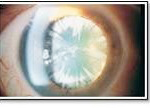 Inside our eyes, we all have a lens which helps to focus our vision. Over time, the lens naturally becomes cloudy. This clouding of the lens is called a cataract. Common symptoms of cataract include blurry vision, hazy vision, glare, halos, and decreased nighttime vision which may impair driving. As cataracts advance, these symptoms may become increasingly bothersome, and your vision may not improve with a change in glasses. At this point, cataract surgery may be recommended.
Inside our eyes, we all have a lens which helps to focus our vision. Over time, the lens naturally becomes cloudy. This clouding of the lens is called a cataract. Common symptoms of cataract include blurry vision, hazy vision, glare, halos, and decreased nighttime vision which may impair driving. As cataracts advance, these symptoms may become increasingly bothersome, and your vision may not improve with a change in glasses. At this point, cataract surgery may be recommended.
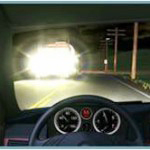 Cataract surgery is performed under light sedation and is done as an outpatient procedure. It is a relatively safe and successful procedure. The cloudy lens is removed by making a small opening on the surface of the eye and a lens implant is placed. Hawaii Eye Clinic offers several lens implants choices (Toric lens or Multifocal lens) in order to reduce dependency on glasses after surgery.
Cataract surgery is performed under light sedation and is done as an outpatient procedure. It is a relatively safe and successful procedure. The cloudy lens is removed by making a small opening on the surface of the eye and a lens implant is placed. Hawaii Eye Clinic offers several lens implants choices (Toric lens or Multifocal lens) in order to reduce dependency on glasses after surgery.
Dry Eye
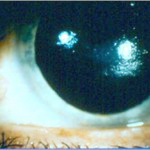 Dry eye disease is a common condition that affects many people, especially our older patients. Dry eye may be caused by decreased tear production or increased tear evaporation. Symptoms such as eye irritation, redness, eye pain, tearing, itching, discharge, pain around the eyes, headache, and blurry vision with prolonged reading, computer use or watching TV may be due to dry eye.
Dry eye disease is a common condition that affects many people, especially our older patients. Dry eye may be caused by decreased tear production or increased tear evaporation. Symptoms such as eye irritation, redness, eye pain, tearing, itching, discharge, pain around the eyes, headache, and blurry vision with prolonged reading, computer use or watching TV may be due to dry eye.
 ounger patients may develop dry eyes from contact lens use, excessive computer use, dehydration from excessive alcohol intake, or taking certain medications. There are many therapies for dry eyes such as artificial tears, omega-3 fatty acid supplements, warm compress, punctal plug insertion, prescription eye drops and oral medications. In our clinic, we use the tear osmolarity test to aid in the diagnosis and treatment of dry eyes.
ounger patients may develop dry eyes from contact lens use, excessive computer use, dehydration from excessive alcohol intake, or taking certain medications. There are many therapies for dry eyes such as artificial tears, omega-3 fatty acid supplements, warm compress, punctal plug insertion, prescription eye drops and oral medications. In our clinic, we use the tear osmolarity test to aid in the diagnosis and treatment of dry eyes.
Glaucoma
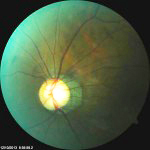 Glaucoma is a disease that may result in decreased peripheral vision due to damage to the optic nerve. In advanced stages, it can cause blindness if left untreated. It is estimated that 3 million Americans have glaucoma, many of whom are not aware of the disease. In Japan, glaucoma is even more common and one in 17-20 people over 40 years old develops glaucoma, which is twice as common compared to the US.
Glaucoma is a disease that may result in decreased peripheral vision due to damage to the optic nerve. In advanced stages, it can cause blindness if left untreated. It is estimated that 3 million Americans have glaucoma, many of whom are not aware of the disease. In Japan, glaucoma is even more common and one in 17-20 people over 40 years old develops glaucoma, which is twice as common compared to the US.
Since Hawaii has many Japanese descendants, glaucoma is frequently diagnosed during routine eye exams. During your exam at Hawaii Eye Clinic, we carefully monitor for signs of glaucoma. When glaucoma is suspected, we use the latest technology such as HD-OCT and Visual Field Analyzer to aid in early diagnosis and treatment. Once diagnosed, treatment is recommended. Studies have shown that glaucoma progression can be slowed by reducing intraocular pressure.
 There are 3 major treatment options for reducing intraocular pressures; eye drops, laser treatment, and surgery. Since we cannot fix the damaged nerve, it is critical to find the disease early and initiate treatment early. If you have a family member who has glaucoma, or you are over 40 years old and never had a dilated exam, a comprehensive eye exam is recommended.
There are 3 major treatment options for reducing intraocular pressures; eye drops, laser treatment, and surgery. Since we cannot fix the damaged nerve, it is critical to find the disease early and initiate treatment early. If you have a family member who has glaucoma, or you are over 40 years old and never had a dilated exam, a comprehensive eye exam is recommended.
Diabetic eye disease
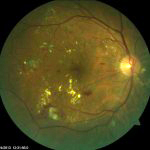 The retina is the tissue that lines the inside of the eye. The retina detects light and consists of numerous nerve fibers that constantly send signals to the brain. The retina can be affected in people with diabetes, especially when their blood sugars are poorly controlled. When a person develops diabetic retinopathy, bleeding and swelling of the retina occurs and the vision may be affected.
The retina is the tissue that lines the inside of the eye. The retina detects light and consists of numerous nerve fibers that constantly send signals to the brain. The retina can be affected in people with diabetes, especially when their blood sugars are poorly controlled. When a person develops diabetic retinopathy, bleeding and swelling of the retina occurs and the vision may be affected.
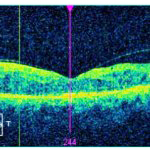 Blindness may result if left untreated.diabetic-graphEarly detection with routine eye exam in diabetic patients is critical in preventing such complications. Treatment may include laser surgery and intraocular injections of medication. Since Dr. Yamamoto is a fellowship trained specialist in this field, Hawaii Eye Clinic offers different types of treatment for diabetic eye disease.
Blindness may result if left untreated.diabetic-graphEarly detection with routine eye exam in diabetic patients is critical in preventing such complications. Treatment may include laser surgery and intraocular injections of medication. Since Dr. Yamamoto is a fellowship trained specialist in this field, Hawaii Eye Clinic offers different types of treatment for diabetic eye disease.
Floaters & Flashing lights
You may see some black spots or clouds moving in your field of vision. Those objects will follow when you look around and are especially more prominent when you are looking at plain backgrounds such as the sky and white wall and at brightly lit computer screens. These specks are called “floaters.” Along with floaters, you may notice “flashing lights” where small stars appear in a dark room especially when moving around your eyes. Those floaters and flashing lights are usually caused by liquefaction of the gel inside the eye, most commonly due to aging. It is usually not harmful to the eyes and symptoms of floaters and flashes will subside over time.
However, there are some conditions with similar symptoms that require treatment. Examples include retinal tear, retinal detachment, and diabetic retinopathy with bleeding inside the eye. In such cases, urgent treatment may be needed. In order to identify the cause of floaters, a dilated exam is recommended.
Age-related Macular Degeneration
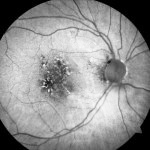 Age-related Macular Degeneration (AMD) The macula is a small part of the retina that helps identify small details, allowing you to read small print, to read street signs, and to thread a needle. Macular degeneration is a disease where this macula becomes dysfunctional. There are two types of macular degeneration, Dry and Wet. The dry form is more common and may not cause any visual symptoms; however, it may cause a gradual loss in central vision or may even progress to the Wet form. Some patients with the dry form may benefit from taking a specially-formulated vitamin regimen.
Age-related Macular Degeneration (AMD) The macula is a small part of the retina that helps identify small details, allowing you to read small print, to read street signs, and to thread a needle. Macular degeneration is a disease where this macula becomes dysfunctional. There are two types of macular degeneration, Dry and Wet. The dry form is more common and may not cause any visual symptoms; however, it may cause a gradual loss in central vision or may even progress to the Wet form. Some patients with the dry form may benefit from taking a specially-formulated vitamin regimen.
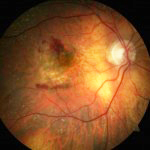 Ten percent of patients with macular degeneration develop the Wet form. Abnormal vessels grow under the retina resulting in hemorrhage and fluid leakage. This process causes acute blurry vision, distorted vision or black spots in the central vision. Intraocular injection of medication to reduce these abnormal blood vessels may help restore your vision. Dr. Yamamoto is a medical retina specialist who performs intraocular injections in the clinic.
Ten percent of patients with macular degeneration develop the Wet form. Abnormal vessels grow under the retina resulting in hemorrhage and fluid leakage. This process causes acute blurry vision, distorted vision or black spots in the central vision. Intraocular injection of medication to reduce these abnormal blood vessels may help restore your vision. Dr. Yamamoto is a medical retina specialist who performs intraocular injections in the clinic.
